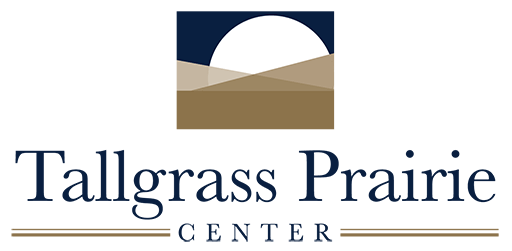Mechanical Methods for Brush Control
Table of Contents
Mechanical methods are the most appropriate for controlling woody vegetation on a large scale. If trees or brush on private property need to be cut as part of the plan for a particular site, existing policy on brush removal from private property should be followed, and a signed written agreement should be obtained before the work is performed. See Appendix 8B for an example log disposal policy used by Fayette County Road Department.
Equipment
Excavator
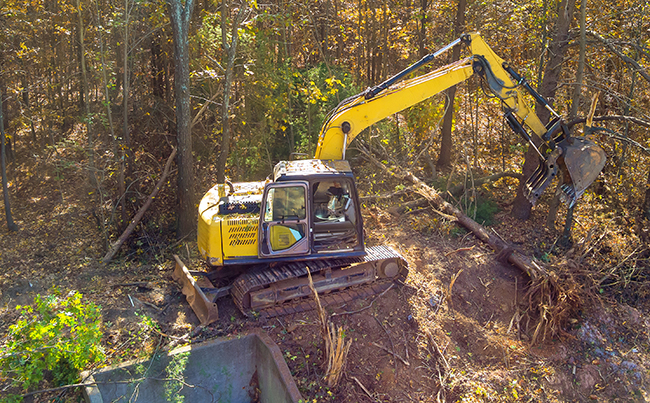
While excavators are often used to move large amounts of earth and rock, they can also be used to clear trees and brush. The excavator operator can use the large bucket attached to the hydraulic arm to dig around the root ball of a tree to grab it and pull it out of the ground. This method of permanently removing the plant is known as “grubbing.” A disadvantage of grubbing is the soil disturbance it causes, which can result in erosion and the growth of invasive weeds unless the site is reseeded with vegetation. The cost of reseeding should be considered. Alternatively, to minimize soil disturbance, the cut stump treatment can be applied.
For smaller brush, the excavator bucket teeth can be used to rake woody debris into piles. Contracting with a skilled excavator operator can facilitate the efficient clearance of large trees and brush.
Bulldozer
Bulldozers can be used to push over trees with their large blades. Invasive species may invade the bare ground left in areas treated by bulldozers unless the ground is reseeded.
With both excavators and bulldozers, it is important to have skilled operators who know how to properly fell a tree so it does not damage equipment or injure people.
Bucket Truck
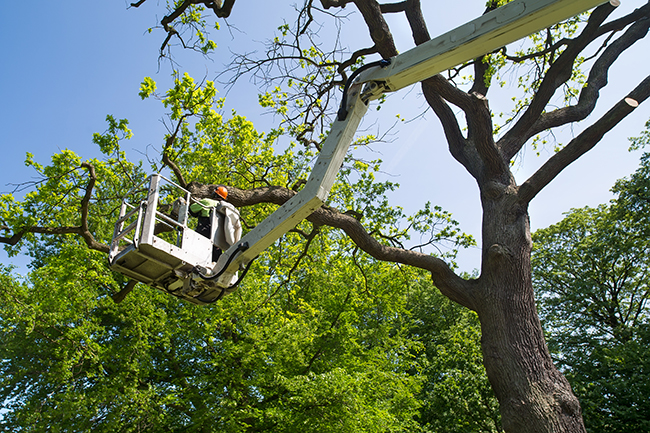
A bucket truck can lift roadside managers into the tree and shrub canopy in areas where steeper grades limit access by foot. It can also be used when branches on tall trees overhanging the road need to be managed. While in the bucket, staff may trim branches with a chainsaw or pole pruner.
For safety, employees should wear a fall restraint safety belt system or a full-body harness fall arrest system that tethers the worker to the lift. Follow Occupational Safety and Health Administration guidelines (1910.333(c)(3)(i)) that call for remaining a safe distance from power lines.
Boom Mower
A boom mower attaches to a tractor or loader and can be used to cut brush, small trees, and grass in areas that are difficult to reach, such as behind guardrails and down steep slopes. The hydraulically operated arm can be raised, lowered, and angled as needed.
Forestry Heads
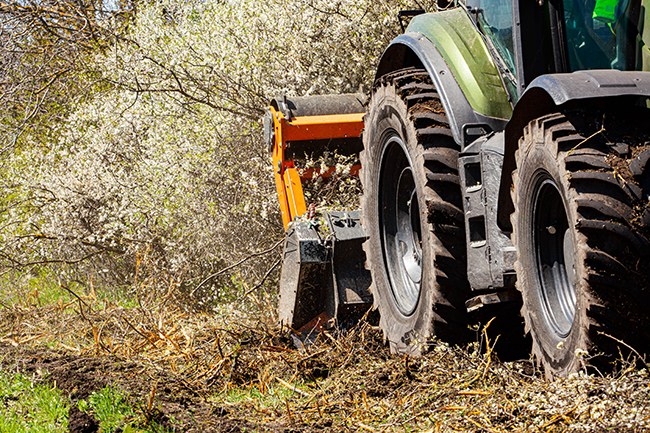
A forestry head is a cutting head that can be attached to a skid steer, tractor, excavator, or bulldozer. Forestry mulchers are a type of forestry head that uses a rotating drum or blades to cut and grind woody vegetation, turning it into mulch. Depending on the model, forestry heads are designed to mulch much larger vegetation. They can cut and mulch trees up to 15 inches in diameter and mulch smaller trees up to 8 inches in diameter. However, some species are more stringy and difficult to cut and mulch with a forestry head (e.g., elm and hackberry).
Forestry heads can be used to remove brush and grind stumps. They are more powerful than handheld brush cutters (see Brush Cutters below) and more suitable for clearing dense brush and trees. Forestry mowers, another type of forestry head, can typically handle woody vegetation up to 8 inches in diameter, although some models can cut larger vegetation.
There are two types of forestry mowers, rotary and drum, which are described separately below. The necessary maintenance is minimal for both, consisting of greasing and rotating the blades or cutting teeth. Carbide cutting teeth last longer than blade systems and may be preferred unless shrubs are the primary vegetation being cut. Some roadside managers have noticed that the teeth can last a long time if they are kept high enough during the cutting process so that they do not get too dirty with soil, and if the teeth are cleaned regularly.
Rotary Forestry Mowers
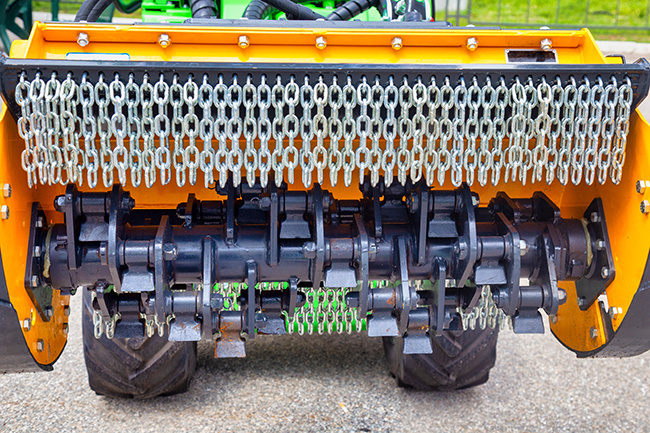
These mowers employ a spinning set of blades or teeth on a rotating drum to cut and shred vegetation. They can clear more acres in a day than drum forestry mulchers. However, rotary-style mowers may throw large chunks of mulch onto the road, which can be dangerous if left there. Chunks may also be thrown into adjacent farmers’ fields, which can impact farming efforts and upset the farmers. Roadside managers should set aside time after mowing with rotary forestry mowers to pick up any flung chunks.
Drum Forestry Mowers
These mowers use a cylindrical drum with multiple cutting teeth that rotate vertically to mulch material. They are slower than rotary forestry mowers but leave behind a cleaner work area by producing smaller chips that are not thrown as far as the chunks produced by rotary forestry mowers. Drum heads are also better at grinding stumps, including large stumps, into chips by going over them multiple times. The drum can then be put into the ground to incorporate the chips into the soil.
Tree Shear
A tree shear can be placed on a smaller piece of equipment than a forestry head. Often mounted on skid steers, these attachments shear trees with a pair of blades, which is effective for cleanly cutting small-diameter trees while producing minimal debris. Because of their precision, tree shears can be useful for selective tree removal. Depending on the species, some trees removed this way may regrow, and the stumps may need to be treated with herbicides.
Wood Chipper/Tree Shredder
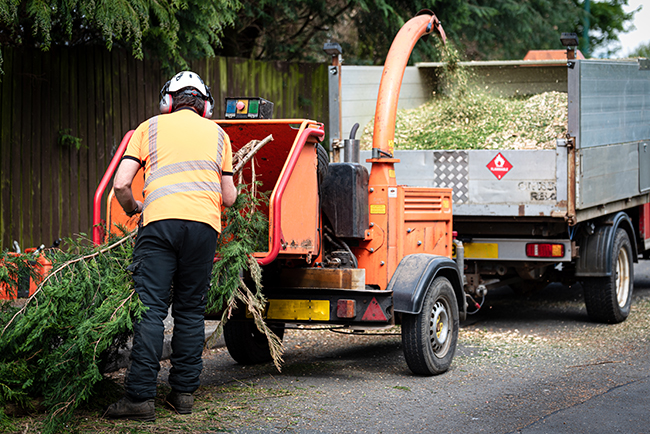
A wood chipper, also known as a “tree shredder,” cuts branches into smaller wood chips for mulch or compost, making it easier to transport tree waste to the landfill or public works department. Similarly, a tree shredder processes smaller plant material, such as small branches and twigs. When it comes to these two machines, it is more common for roadside managers to use wood chippers. The woody vegetation that goes into wood chippers or tree shredders is cut down using equipment such as loppers, bow saws, chainsaws, or forestry mowers. The type of equipment needed will depend on the size of the shrub or tree. Roadside managers then feed the branches into the wood chipper. For trimming small woody roadside vegetation, a wood chipper with a capacity of 9 to 12 inches will probably be sufficient. A chipper with a capacity of 15 to 19 inches is better for large trees. Check with an equipment dealer to ensure you get the right capacity for your needs.
Diesel wood chippers typically cost more than gas wood chippers, but usually use less fuel, are more powerful, and can handle larger branches. While diesel wood chippers may be more durable than gas wood chippers, they also have a more complex design and may require more maintenance.
Another choice to make when buying a wood chipper is whether to buy one with a drum or a disc. Drum chippers use a rotating drum with knives, while disc chippers use a disc with blades. Drum chippers can quickly process large amounts of wood. Disc chippers are better at producing more uniformly sized chips. With their larger size and greater power, drum chippers typically cost more than disc chippers.
Wood chippers can be towed behind a dump trailer or box-bed truck. This allows for chipping and mulching directly into the truck bed and easy dumping of the mulch afterward.
A wood chipper winch (a mechanical rotating spool for pulling an object attached to a cable back toward the spool) pulls large and difficult-to-reach branches and limbs up to the chipper, requiring less manual labor from the chipper operator. It is handy when pulling brush from narrow locations that a wood chipper cannot access, such as the roadside. It also makes the work safer, since operators spend less time near the chipper’s feeding mechanism.
Brush Mower
These mowers, also known as “rotary cutters,” use wedge-like blades to cut through thick vegetation, such as small trees and bush, and are effective for clearing large, overgrown areas. Tow-behind brush mowers can be used with ATVs, UTVs, or lawn tractors. Brush mowers can throw roadside debris, such as metal cans, at high velocities toward the road and the mower operator. To reduce this safety risk, check chains (also known as “deflector chains” or “rock guards”) or heavy mesh screens can be installed on the front and back to deflect or slow down debris.
Brush mowers are also available as large, heavy, and powerful walk-behind lawnmowers. They use a heavy blade to cut through woody brush and saplings. Some units must be pushed, while others are self-propelled, so the user only has to steer. Brush mowers are helpful for small patches of brush.
Tow-behind and walk-behind brush mowers are available in electric- or gas-powered versions. Electric-powered brush mowers have a lower noise level, lower emissions, are easier to maintain, and weigh less. Gas-powered brush mowers have more power and are better for cutting through thick vegetation. Gas-powered brush mowers are more flexibly mobile since they do not rely on a power cord or battery.
Brush Cutter
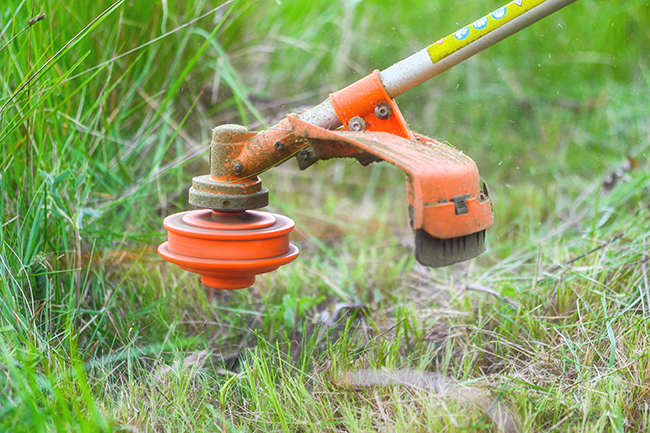
Brush cutters (also known as “weed eaters” or “clearing saws”) are handheld metal blades with multiple cutting edges or thick nylon cords attached to a spinning head. They cut thick weeds, small saplings, and light brush by chopping them as the head moves through the plants. They are easy to operate and effective on smaller woody vegetation. Unlike mowers, brush cutters cut and trim, leaving behind debris instead of mulch.
Chainsaws
Chainsaws are available in many sizes and at various prices. They are used to fell trees, prune branches, and cut logs into smaller pieces. The chainsaw bar length should be at least two inches longer than the diameter of the vegetation being cut. Branches should be pruned following the American National Standards Institute A300 Tree Care Standards.
When using a chainsaw to fell a tree, cut the stumps to within 3–4 inches of the ground. Treating stumps with herbicide after cutting with the cut stump treatment approach described previously prevents the stump from producing sprouts.
When using a chainsaw at a work site, it can be helpful to have a toolbox with sharpening tools, extra chains, screnches (a tool combining a wrench and a screwdriver), wedges, and other tools needed to fix saws or aid in the felling process.

